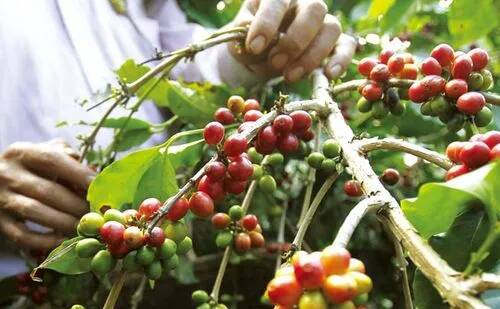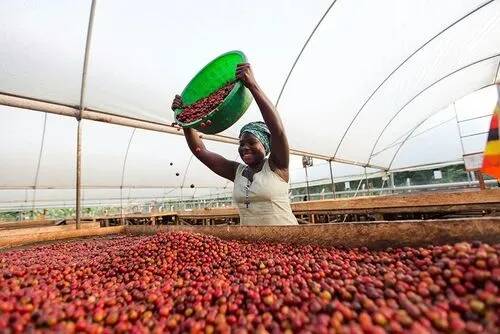Introduction of coffee history, coffee producing areas and coffee varieties in Uganda, an African country
Uganda is a country located in eastern Africa, straddling the equator, bordering Kenya to the east, Tanzania and Rwanda to the south, the Democratic Republic of the Congo to the west and South Sudan to the north. Most of the country is located in the East African Plateau, many lakes, the average elevation of 1000-1200 meters, known as "plateau water village".
Uganda has a tropical steppe climate, with an average annual temperature of 22.3 ℃ and annual rainfall of between 1 000 mm and 1500 mm in most areas. The rainy seasons are from March to May and from September to November each year, and the rest are two dry seasons. The natural conditions are good, the land is fertile and the climate is suitable, so coffee is one of the main cash crops in the country.

Uganda is one of the few countries in the world with native coffee trees, which grow in the wild Robusta around Lake Victoria. Arabica was introduced to Uganda from Malawi or Ethiopia in the 20th century, but it was not widely planted because of Arabica's weak disease resistance, while Robusta's coffee varieties with strong disease resistance began to be planted on a large scale.
Coffee exports accounted for only 1% of Uganda's export trade in 1925. In 1929, coffee industry committee (Coffee Industy Board), cooperative planting and production promoted the growth of coffee industry. In 1940, coffee became Uganda's main export trade product. But in 1990, due to drought, a collapse in coffee prices and farmers growing other crops, coffee production in Uganda fell by 20%. It was not until the 1990s that the coffee industry began to modernize.

The coffee producing areas in Uganda are roughly divided into three regions: Bugisu, West Nile (West Nile) and Renzori Mountain (Rwenzori Mountains), mostly from producers' unions or cooperatives. Wugar (washing Arabica) and Drugar (tanning Arabica) are unique to Uganda. Uganda is mainly divided into two production seasons.
Bugisu, a region of the Elgon Mountains in the east of the country near the Kenyan border, has high-quality soil, altitude and microclimate. At 1500-2300 meters above sea level, the main harvest season is from October to March of the following year, and the secondary season is from May to July. Arabica varieties such as kent, iron pickup, SL14 and SL28 are mainly planted.
West Nile (West Nile) West Nile region, located in northwestern Uganda, grows more Arabica varieties, Arabica near Lake Albert (Lake Albert) and Robusta to the north. At 1450-1800 meters above sea level, the main production season is from October to January of the following year, and the secondary season is from April to June. The planting varieties are Kent, Tieka, SL14, SL28 and the original species Robsta.
Mount Renzori (Rwenzori Mountains) is located in the Renzori Mountains in western Uganda, near the Democratic Republic of the Congo (DRC) border. Drugar (sunning Arabica) is a common treatment in this area. 1200-2200 meters above sea level, April to July is the main production season, October to January of the following year is the secondary season. Mainly grow Kent, iron pickup, SL14, SL28 and native species Robusta.
Important Notice :
前街咖啡 FrontStreet Coffee has moved to new addredd:
FrontStreet Coffee Address: 315,Donghua East Road,GuangZhou
Tel:020 38364473
- Prev

Is there a hole in the pressed powder of espresso? Is it the channel effect? What is the channel effect of espresso?
The word "channel effect" often appears in articles on Qianjie! So I believe that when we are usually concentrated in the extraction, we will more or less encounter the channel effect! For example, there are some holes in the surface of pressed powder after the concentrated extraction, or sputtering or water column when using bottomless handle.
- Next

Excellent Cup COE holds "Origin Immersion" program in El Salvador to promote Salvadoran coffee
Recently, the COE Cup is holding a multi-day education program aimed at immersing international coffee professionals to experience the coffee and culture of specific coffee producing countries. For the first time, the project has a relationship with Instituto Salvadore ñ o Del Caf é (El Salvador)
Related
- Caught off guard! Starbucks '15-year-old store quietly closes!
- Naixue Drink drank a stone and claimed a claim was retaliated by the merchant?!
- What is the difference between a cake filter cup and a V60 conical filter cup? What are the advantages and disadvantages of the flat-bottomed filter cup brewing solution?
- What is the difference between fine coffee powder and medium coarse coffee powder? Do I need to sift out the fine coffee powder for making coffee by hand?
- Why does hot American coffee taste bitter? Difference in proportional concentration between hot American and ice American
- Is espresso stored overnight in the refrigerator harmful to your body? Is frozen coffee better than freshly ground coffee?
- What parameters and proportions of water temperature should be used to grind and brew fresh coffee beans? Why can't I drink freshly roasted coffee right away?
- Customers have "changed" Manner's new products! Shop assistant: Please don't mess around!
- Remove sockets in customer areas at Starbucks stores?! Netizen: I won't go if I really tear it down
- What is the difference between the taste steps of sun-dried coffee and washed coffee? Why is sun-cured coffee sweeter and washed coffee sour?

